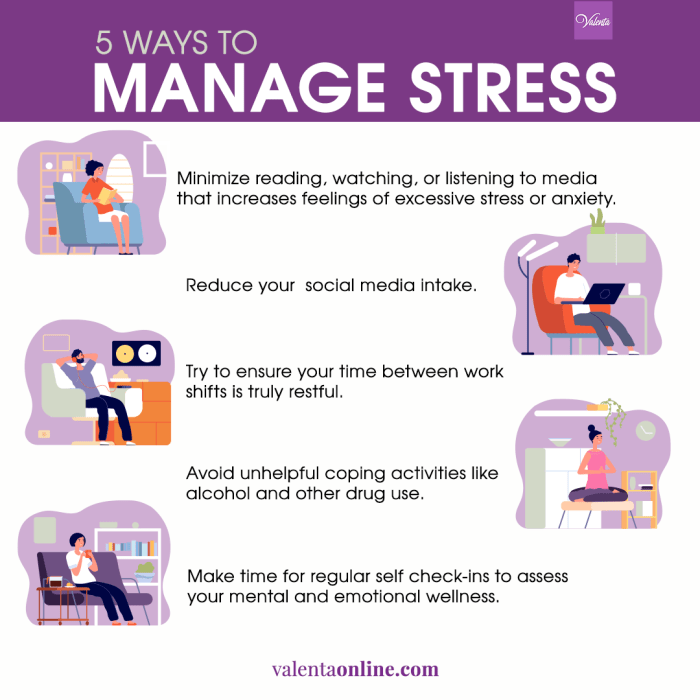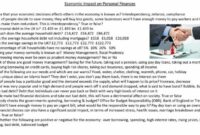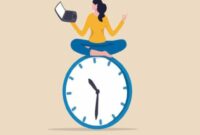Strategies for managing stress and anxiety in modern life are more crucial than ever. Our fast-paced, hyper-connected world bombards us with constant demands, leaving many feeling overwhelmed and depleted. This guide explores practical techniques to navigate these challenges, from mindfulness and lifestyle changes to cognitive behavioral strategies and seeking professional support. We’ll examine the root causes of stress and anxiety in today’s society, providing actionable steps to reclaim your well-being and cultivate a more balanced and fulfilling life.
We’ll cover a wide range of approaches, including practical tips for time management, building strong social connections, and incorporating self-care into your daily routine. Understanding the physical manifestations of stress and anxiety is also key, and we’ll discuss how to address these symptoms effectively. Ultimately, the goal is to empower you to develop a personalized stress management plan that works best for your individual needs and lifestyle.
Identifying Stress and Anxiety Triggers in Modern Life
Modern life presents a unique set of challenges that can significantly impact our mental well-being. Understanding the sources of our stress and anxiety is the crucial first step towards effective management. By recognizing these triggers, we can develop personalized strategies to mitigate their negative effects and cultivate a healthier, more balanced life.
Common Stressors in Modern Life
The following table categorizes common stressors, highlighting their diverse origins and impacts. Recognizing where your stress originates can help you tailor coping mechanisms more effectively.
| Personal Factors | Professional Factors | Societal Factors | Technological Factors |
|---|---|---|---|
| Relationship problems | Work overload/deadlines | Economic instability/recession | Social media comparison/cyberbullying |
| Financial difficulties | Job insecurity/unemployment | Political polarization/uncertainty | Constant connectivity/information overload |
| Health concerns | Difficult colleagues/boss | Climate change anxiety | Fear of missing out (FOMO) |
| Family issues | Lack of work-life balance | Social inequality/discrimination | Online harassment/trolling |
The Impact of Technology on Stress and Anxiety
Technology, while offering incredible benefits, also contributes significantly to stress and anxiety. The constant connectivity fostered by smartphones and social media platforms creates a relentless stream of information and expectations. This can lead to feelings of inadequacy, pressure to constantly be “on,” and a fear of missing out (FOMO). Social media, in particular, often presents a curated and unrealistic portrayal of others’ lives, leading to social comparison and feelings of low self-esteem.
The pressure to maintain an online persona can be exhausting and contribute to anxiety. Constant notifications and the expectation of immediate responses blur the lines between work and personal life, further exacerbating stress. For example, studies have shown a correlation between increased social media usage and higher rates of anxiety and depression, particularly among young adults.
The Role of Societal Pressures on Stress and Anxiety
Societal pressures significantly contribute to widespread stress and anxiety. Financial insecurity, driven by factors like inflation, job losses, and rising living costs, creates immense pressure and uncertainty. The current political climate, often characterized by division and uncertainty, can also fuel anxiety and stress. News cycles filled with conflict and negativity can contribute to a sense of helplessness and fear.
Furthermore, societal pressures related to achieving certain milestones (career success, marriage, family) can create immense stress, particularly when individuals feel they are falling short of expectations. The pervasive nature of these pressures means that many individuals experience these stressors simultaneously, compounding their impact on mental well-being. For instance, the increasing cost of living combined with political uncertainty can leave individuals feeling overwhelmed and anxious about their future.
Mindfulness and Meditation Techniques
Mindfulness and meditation are powerful tools for navigating the stresses of modern life. They offer practical techniques to help you become more aware of your thoughts, feelings, and bodily sensations, allowing you to respond to challenges with greater calm and clarity rather than reacting impulsively. By cultivating a present-moment focus, you can break free from the cycle of worry and anxiety that often grips us.Mindfulness is essentially paying attention to the present moment without judgment.
It involves observing your thoughts, feelings, and sensations as they arise, acknowledging them without getting carried away by them. This non-judgmental awareness helps to create mental space, reducing the intensity of overwhelming emotions and allowing for a more balanced perspective. Applying mindfulness to daily life can involve anything from paying close attention to the taste of your food to noticing the sensations of your breath as you walk.
This conscious engagement with the present moment helps to ground you and reduce feelings of anxiety about the future or regret about the past.
A Simple Mindfulness Meditation Exercise
Practicing mindfulness meditation regularly can significantly improve your ability to manage stress and anxiety. Here’s a step-by-step guide to a simple exercise you can do anytime, anywhere:
- Find a quiet space where you can sit or lie down comfortably. Minimize distractions as much as possible.
- Close your eyes gently. You don’t have to force them shut; a soft closure is sufficient.
- Bring your attention to your breath. Notice the sensation of the air entering and leaving your nostrils, or the rise and fall of your abdomen. Don’t try to control your breath; simply observe it.
- As you focus on your breath, your mind will inevitably wander. This is perfectly normal. When you notice your mind has drifted, gently guide your attention back to your breath without judgment. Think of it like gently redirecting a playful puppy.
- Continue this practice for 5-10 minutes. Start with shorter periods and gradually increase the duration as you become more comfortable.
- When you’re ready, slowly open your eyes and take a few moments to transition back to your surroundings.
Different Types of Meditation Practices and Their Benefits
Various meditation techniques cater to different preferences and needs. Each offers unique benefits for stress and anxiety reduction.
- Walking Meditation: This involves paying close attention to the physical sensations of walking – the feeling of your feet on the ground, the movement of your legs, and the rhythm of your steps. It combines mindfulness with gentle physical activity, offering a calming and grounding experience. Benefits include stress reduction, improved body awareness, and enhanced focus.
- Guided Meditation: This type of meditation involves following a recorded voice that guides you through various visualizations, affirmations, or breathing exercises. Guided meditations can be particularly helpful for beginners, providing structure and support. Benefits include reduced anxiety, improved sleep, and increased self-compassion.
- Transcendental Meditation (TM): This technique involves the silent repetition of a personalized mantra, promoting a state of deep relaxation and inner peace. TM requires instruction from a certified teacher. Benefits include stress reduction, improved cardiovascular health, and enhanced creativity.
Lifestyle Changes for Stress Reduction
Making significant lifestyle changes can be a powerful tool in managing stress and anxiety. These changes aren’t about drastic overhauls, but rather about incorporating small, sustainable adjustments into your daily routine that cumulatively contribute to a more balanced and less stressful life. It’s about creating a lifestyle that supports your mental and physical well-being.
Finding ways to manage stress and anxiety is crucial in today’s fast-paced world. Sometimes, the best stress relief isn’t a spa day, but a deeper sense of well-being. That’s why learning to prioritize experiences over material possessions is key; check out this article on How to find authentic luxury experiences instead of superficial ones for ideas.
Ultimately, cultivating mindful moments and genuine connections contributes significantly to a calmer, more balanced life, reducing stress and anxiety levels.
A Sample Weekly Schedule Incorporating Stress-Reducing Activities
This sample schedule demonstrates how to integrate exercise, healthy eating, and sufficient sleep into a typical week. Remember, this is a template; adjust it to fit your individual needs and preferences. Consistency is key, so aim for gradual implementation rather than immediate, overwhelming change.
| Day | Morning | Afternoon | Evening |
|---|---|---|---|
| Monday | 30-minute brisk walk, healthy breakfast | Lunch break mindfulness exercise (5 minutes), prepare dinner | Relaxing bath, early bedtime (aim for 10pm) |
| Tuesday | Yoga or stretching, nutritious breakfast | Work/Study break for a short walk, light snack | Read a book, wind-down routine |
| Wednesday | Strength training workout, healthy breakfast | Mindful eating during lunch, afternoon tea (herbal tea) | Prepare for the next day, early bedtime |
| Thursday | 30-minute jog or cycling, healthy breakfast | Lunch break meditation, healthy snack | Spend time with loved ones, early bedtime |
| Friday | Restorative yoga, healthy breakfast | Prepare a healthy lunch, mindful break | Movie night (with healthy snacks), early bedtime |
| Saturday | Longer hike or outdoor activity, brunch with friends/family | Relaxing activity (e.g., gardening, reading), healthy lunch | Social activity or hobby, early bedtime |
| Sunday | Sleep in (slightly!), leisurely breakfast | Meal prep for the week, relaxing activity | Prepare for the week ahead, early bedtime |
The Importance of Regular Physical Activity and its Impact on Stress Hormones
Regular physical activity is crucial for stress management. Exercise helps regulate stress hormones like cortisol and adrenaline. When we exercise, our bodies release endorphins, which have mood-boosting effects and act as natural stress relievers. Even moderate exercise, such as a brisk walk or a bike ride, can significantly reduce stress levels and improve overall mood. The intensity and duration of exercise should be tailored to individual fitness levels, but aiming for at least 30 minutes of moderate-intensity exercise most days of the week is generally recommended.
Studies have shown a strong correlation between regular physical activity and reduced symptoms of anxiety and depression.
Finding ways to manage stress and anxiety is crucial in today’s fast-paced world. Many people find that achieving financial security significantly reduces stress; building a solid foundation often involves exploring diverse income streams, and a great resource for this is learning about Securing a luxury lifestyle through passive income streams. Ultimately, financial freedom contributes to a more relaxed and balanced lifestyle, freeing up mental space to focus on other aspects of well-being.
Healthy Meal Options That Promote Mental Well-being
Nourishing your body with healthy foods directly impacts your mental state. A balanced diet provides the essential nutrients your brain needs to function optimally and cope with stress.
- Breakfast: Oatmeal with berries and nuts, Greek yogurt with fruit, whole-wheat toast with avocado.
- Lunch: Salad with lean protein (chicken, fish, beans), lentil soup, whole-wheat sandwich with vegetables.
- Dinner: Baked salmon with roasted vegetables, chicken stir-fry with brown rice, vegetarian chili.
- Snacks: Fruits (apples, bananas, oranges), vegetables (carrots, celery), nuts, seeds, yogurt.
The Connection Between Sleep Quality and Stress Management
Sufficient, high-quality sleep is fundamental to effective stress management. When we’re sleep-deprived, our bodies release more cortisol, making us more susceptible to stress. Aim for 7-9 hours of sleep per night. Establish a regular sleep schedule, create a relaxing bedtime routine (avoid screens before bed), and ensure your sleep environment is dark, quiet, and cool. Improving sleep quality can significantly reduce stress levels and improve cognitive function, emotional regulation, and overall well-being.
Consistent sleep patterns are vital for maintaining hormonal balance and reducing the negative impact of stress on the body.
Cognitive Behavioral Techniques (CBT)
Cognitive Behavioral Therapy (CBT) is a powerful tool for managing stress and anxiety by focusing on the connection between thoughts, feelings, and behaviors. It helps individuals identify and change negative thought patterns and unhelpful behaviors that contribute to their distress. The core principle is that our thoughts significantly influence our emotions and actions, and by modifying these thoughts, we can improve our overall well-being.CBT operates on the premise that our reactions to events are not solely determined by the events themselves, but also by our interpretations of those events.
This means that even seemingly negative situations can be viewed in a more positive or neutral light through cognitive restructuring. By challenging and reframing unhelpful thoughts, CBT empowers individuals to develop more adaptive coping mechanisms and reduce the intensity of their emotional responses.
Cognitive Restructuring Techniques
Cognitive restructuring involves identifying and challenging negative or distorted thought patterns, replacing them with more balanced and realistic ones. This process often begins with identifying automatic thoughts – those fleeting, often negative, thoughts that pop into our minds without much conscious effort. For example, someone might experience an automatic thought like “I’m going to fail this presentation” before a work presentation.
This thought, while seemingly harmless, can trigger anxiety and negatively impact performance. Through CBT, this thought can be challenged. Techniques include examining the evidence supporting and contradicting the thought, considering alternative explanations, and exploring the potential consequences of believing the thought. For instance, the individual might consider past successful presentations, their preparation for the current presentation, and the potential for constructive feedback rather than complete failure.
Finding effective strategies for managing stress and anxiety is crucial in today’s fast-paced world. Planning for a comfortable future is a key part of this, and that often involves smart financial decisions. Check out this guide on Best ways to invest for a luxury lifestyle retirement to alleviate future financial worries, a major source of stress for many.
Ultimately, reducing financial anxiety contributes significantly to overall well-being and a more relaxed life.
By examining the evidence and considering alternatives, the individual can replace the catastrophic thought with a more realistic and less anxiety-provoking one, such as “I’ve prepared well, and while there’s always some risk, I’m capable of delivering a good presentation.”
Identifying and Challenging Negative Self-Talk, Strategies for managing stress and anxiety in modern life
Negative self-talk, characterized by self-criticism, pessimism, and self-doubt, is a common feature of anxiety and stress. Identifying these negative patterns is crucial. This can be done through self-monitoring, keeping a journal to record negative thoughts and their associated feelings and behaviors. Once identified, these thoughts can be challenged using techniques like examining the evidence, considering alternative explanations, and practicing self-compassion.
For example, if someone consistently tells themselves “I’m a failure,” they can challenge this by listing their accomplishments, acknowledging their strengths, and reframing their mistakes as learning opportunities. Instead of focusing on perceived flaws, the individual can practice self-acceptance and cultivate a more positive and supportive inner dialogue. This might involve replacing the self-critical statement with a more balanced and encouraging one, such as, “I’ve faced challenges, but I’m learning and growing from them.” This process, while requiring consistent effort, can significantly improve self-esteem and reduce anxiety levels.
Social Support and Connection
In today’s fast-paced world, it’s easy to feel isolated, even when surrounded by people. Strong social connections, however, are vital for managing stress and anxiety. A robust support network acts as a buffer against life’s challenges, providing emotional resilience and a sense of belonging. Nurturing these relationships is an active investment in your mental well-being.Building and maintaining strong social connections significantly impacts our ability to cope with stress.
Feeling connected to others provides a sense of security and belonging, reducing feelings of loneliness and isolation, both major contributors to anxiety and depression. This sense of belonging acts as a powerful antidote to stress, offering emotional support during difficult times and promoting a more positive outlook. Regular social interaction releases endorphins, natural mood boosters that help alleviate stress and improve overall well-being.
Strategies for Seeking Social Support
The benefits of social support are undeniable, but knowing how to actively seek it out is crucial. This involves identifying reliable individuals in your life and establishing healthy communication patterns.
Reaching out to friends and family can be as simple as a phone call, a text message, or a coffee date. Sharing your feelings and experiences with trusted individuals allows you to process emotions and gain valuable perspectives. For more structured support, consider joining support groups related to specific challenges you face, whether it’s anxiety, grief, or a chronic illness.
These groups provide a safe space to connect with others who understand your experiences, fostering a sense of community and shared understanding. Online communities can also offer valuable connections, but it’s important to be mindful of the potential downsides of online interactions, such as cyberbullying or misinformation.
Benefits of Social Interaction for Mental Health
Regular social interaction offers a multitude of benefits for mental health. Studies have consistently shown a strong correlation between strong social connections and reduced rates of depression, anxiety, and other mental health issues. Social interaction stimulates the release of oxytocin, often called the “cuddle hormone,” which promotes feelings of trust, bonding, and relaxation. Moreover, engaging in social activities provides opportunities for distraction from stressors, promoting a sense of normalcy and routine, and preventing social isolation which can exacerbate mental health challenges.
These interactions also offer a chance to learn coping mechanisms from others and gain new perspectives on challenging situations. The simple act of laughing with friends or engaging in a meaningful conversation can significantly improve mood and reduce stress levels. For example, studies have shown that individuals with strong social support networks recover more quickly from illness and experience less stress during major life transitions.
Time Management and Productivity Strategies
Effective time management is crucial for reducing stress and anxiety. When we feel in control of our time, we’re less likely to feel overwhelmed and anxious about looming deadlines or unfinished tasks. Learning to prioritize and allocate time efficiently can significantly improve our overall well-being.
Implementing time management techniques involves understanding your personal work style, identifying time-wasting activities, and developing strategies to maximize your productivity. This includes not only scheduling tasks but also incorporating breaks and self-care activities to prevent burnout. A balanced approach ensures that you’re both productive and well-rested.
Time Management Techniques for Reducing Overwhelm
Several techniques can help you manage your time more effectively and reduce feelings of overwhelm. Choosing the right strategies depends on your individual needs and preferences. Consistency is key to success with any of these methods.
- Time Blocking: Allocate specific time slots for particular tasks in your day. This helps you visualize your schedule and prevents tasks from bleeding into each other.
- Prioritization Matrices (e.g., Eisenhower Matrix): Categorize tasks based on urgency and importance (urgent/important, important/not urgent, urgent/not important, neither urgent nor important). This allows you to focus on high-impact activities first.
- Pomodoro Technique: Work in focused bursts (e.g., 25 minutes) followed by short breaks (e.g., 5 minutes). This technique improves concentration and prevents mental fatigue.
- Eat the Frog: Tackle your most challenging or unpleasant task first thing in the morning. This creates momentum and reduces the anxiety associated with procrastination.
- Batching Similar Tasks: Group similar tasks together (e.g., answering emails, making phone calls) to minimize context switching and improve efficiency.
Sample Daily Schedule Incorporating Relaxation and Self-Care
This sample schedule demonstrates how to integrate relaxation and self-care into a busy day. Remember, this is just a template; adjust it to fit your individual needs and preferences. The key is to be realistic and consistent.
| Time | Activity |
|---|---|
| 7:00 AM – 7:30 AM | Morning Routine (exercise, meditation, journaling) |
| 7:30 AM – 8:00 AM | Breakfast and planning the day |
| 8:00 AM – 12:00 PM | Focused work block (with short breaks) |
| 12:00 PM – 1:00 PM | Lunch break (mindful eating) |
| 1:00 PM – 5:00 PM | Focused work block (with short breaks) |
| 5:00 PM – 6:00 PM | Relaxation activity (yoga, reading, listening to music) |
| 6:00 PM – 7:00 PM | Dinner |
| 7:00 PM – 8:00 PM | Free time/social time |
| 8:00 PM – 9:00 PM | Prepare for bed (winding down routine) |
| 9:00 PM | Sleep |
Prioritizing Tasks Effectively to Reduce Stress
Effective prioritization is crucial for stress reduction. It allows you to focus your energy on the most important tasks, reducing feelings of overwhelm and improving your sense of accomplishment.
The Eisenhower Matrix (also known as the Urgent-Important Matrix) is a useful tool. It helps categorize tasks based on their urgency and importance. By focusing on important tasks first, even if they aren’t urgent, you prevent crises and build a stronger foundation for your work. Delegating or eliminating less important tasks frees up time and mental space.
Finding ways to manage stress and anxiety is crucial in today’s fast-paced world. Sometimes, the pressure to maintain a certain lifestyle contributes to this stress; consider the impact of choices, like learning more about the environmental consequences of a Luxury lifestyle and its environmental footprint , which can unexpectedly add to our worries. Ultimately, prioritizing sustainable practices and mindful living can reduce both our environmental impact and our stress levels.
Prioritize tasks based on their impact, not just their urgency. Focus on activities that move you closer to your long-term goals.
Relaxation and Self-Care Practices
Incorporating relaxation and self-care into your daily life is crucial for managing stress and anxiety. These practices offer a proactive approach to well-being, counteracting the negative effects of modern pressures. By prioritizing self-care, you build resilience and enhance your ability to cope with challenges effectively. Regular engagement with these techniques helps to reduce stress hormones, improve sleep quality, and boost overall mood.
Progressive Muscle Relaxation Techniques
Progressive muscle relaxation (PMR) is a technique that involves systematically tensing and releasing different muscle groups in the body. This process helps to increase awareness of physical tension and promotes deep relaxation. The method typically starts with the toes and works its way up to the head, or vice-versa. Each muscle group is tensed for a few seconds, followed by a period of complete relaxation.
This tension-release cycle helps to distinguish between tension and relaxation, making it easier to identify and release physical stress throughout the body. Regular practice can lead to a heightened sense of body awareness and a greater ability to manage physical manifestations of stress and anxiety. For example, someone experiencing jaw clenching due to work stress might find PMR particularly helpful in releasing that tension.
Examples of Creative Self-Care Activities
Engaging in creative activities offers a powerful outlet for stress relief and self-expression. These activities allow for a shift in focus, promoting relaxation and emotional processing. For instance, painting allows for emotional expression through color and form, offering a non-verbal way to process feelings. Similarly, playing a musical instrument provides a structured outlet for creativity and emotional release, while the rhythmic nature of music can have a calming effect.
Spending time in nature offers a restorative experience, connecting individuals to a larger context and providing a sense of peace and tranquility. The sights, sounds, and smells of nature can be incredibly soothing, providing a break from the often overwhelming stimuli of daily life. Imagine the feeling of walking barefoot on grass, or the calmness experienced while listening to the sounds of a flowing stream.
Easily Incorporable Self-Care Activities
Prioritizing self-care doesn’t require hours of dedicated time; small, consistent practices can make a significant difference.
- Take short breaks throughout the day to stretch or practice deep breathing exercises.
- Listen to calming music during your commute or while working.
- Engage in a mindful activity, such as drinking tea or eating a meal slowly, paying attention to the sensations.
- Spend 5-10 minutes each day outdoors, even if it’s just sitting on a bench.
- Practice gratitude by writing down three things you are grateful for each day.
- Read a chapter of a book before bed instead of scrolling through social media.
- Incorporate short periods of gentle exercise into your routine, such as a brisk walk during your lunch break.
Seeking Professional Help: Strategies For Managing Stress And Anxiety In Modern Life
Persistent stress and anxiety can significantly impact your overall well-being. While self-help strategies are valuable, sometimes professional guidance is necessary to effectively manage and overcome these challenges. Seeking help is a sign of strength, not weakness, and it can unlock significant improvements in your mental and physical health.Many different types of mental health professionals can provide effective support for stress and anxiety.
Understanding their roles and expertise can help you find the best fit for your needs.
Types of Mental Health Professionals
Several types of professionals can help manage stress and anxiety. Choosing the right one depends on your specific needs and preferences. Therapists often work collaboratively, and a referral from one to another is sometimes beneficial.
- Psychologists: These professionals hold doctoral degrees (Ph.D. or Psy.D.) and are trained in various therapeutic approaches. They can diagnose and treat mental health conditions, including anxiety disorders. They often use evidence-based therapies like Cognitive Behavioral Therapy (CBT).
- Psychiatrists: Psychiatrists are medical doctors (M.D. or D.O.) specializing in mental health. They can diagnose and treat mental health conditions, prescribe medication, and provide psychotherapy. They are particularly helpful when medication is considered necessary.
- Licensed Clinical Social Workers (LCSWs): LCSWs hold master’s degrees in social work and are trained in providing therapy and counseling. They often focus on the social and environmental factors contributing to mental health challenges.
- Licensed Professional Counselors (LPCs): LPCs also hold master’s degrees and are trained in various therapeutic approaches. They provide counseling and therapy to address a wide range of mental health concerns.
- Marriage and Family Therapists (MFTs): MFTs specialize in working with individuals, couples, and families to address relationship issues and other problems that may contribute to stress and anxiety.
Benefits of Seeking Professional Help
Professional help offers several significant advantages in managing persistent stress and anxiety. These benefits extend beyond simply feeling better; they can improve various aspects of your life.
- Personalized Treatment Plan: A mental health professional can assess your specific situation and develop a tailored treatment plan that addresses your unique needs and challenges. This plan might involve therapy, medication, or a combination of both.
- Effective Coping Mechanisms: Therapists teach coping skills and strategies to manage stress and anxiety in healthy ways. These skills can be used in various situations and help you develop greater resilience.
- Improved Self-Awareness: Therapy can help you understand the root causes of your stress and anxiety, leading to greater self-awareness and self-acceptance. This understanding empowers you to make positive changes in your life.
- Reduced Symptoms: With professional help, many individuals experience a significant reduction in the severity and frequency of their stress and anxiety symptoms. This can lead to improved mood, sleep, and overall well-being.
- Enhanced Relationships: Managing stress and anxiety can positively impact your relationships with family, friends, and colleagues. Improved emotional regulation leads to healthier interactions.
Finding a Therapist or Counselor
Finding the right therapist or counselor is a crucial step in the process. Several resources can assist you in your search.
- Insurance Provider: Check your insurance provider’s website or contact them directly to find therapists in your network. This can help you manage the cost of therapy.
- Online Directories: Several online directories, such as Psychology Today or GoodTherapy, allow you to search for therapists based on location, specialization, and other criteria.
- Referrals: Ask your doctor, friends, or family members for referrals to mental health professionals they have had positive experiences with.
- Consider Your Needs: Think about what you hope to achieve through therapy. Do you need someone specializing in a particular approach (CBT, mindfulness, etc.) or someone with experience in a specific area (trauma, anxiety disorders)?
- Initial Consultations: Most therapists offer a brief initial consultation, often at a reduced rate or for free. This allows you to meet the therapist, discuss your needs, and determine if they are a good fit for you before committing to ongoing therapy.
Understanding the Physical Symptoms of Stress and Anxiety

Source: valentaonline.com
Stress and anxiety, while often perceived as mental health concerns, significantly impact our physical well-being. Understanding these physical manifestations is crucial for effective self-management and seeking appropriate support. Recognizing the body’s response to stress allows for proactive strategies to alleviate discomfort and prevent escalation.Stress and anxiety trigger a cascade of physiological responses within the body, leading to a wide range of physical symptoms.
The body’s “fight-or-flight” response, mediated by the sympathetic nervous system, releases adrenaline and cortisol. These hormones increase heart rate, blood pressure, and respiration, preparing the body for immediate action. Prolonged activation of this system, however, can lead to various health problems.
Common Physical Manifestations of Stress and Anxiety
The physical symptoms of stress and anxiety are diverse and can vary in intensity and presentation from person to person. Common symptoms include muscle tension, headaches, digestive problems, sleep disturbances, and cardiovascular issues. Understanding these manifestations is the first step towards effective management.
Muscle Tension and Headaches
Sustained muscle tension is a hallmark of stress and anxiety. The constant state of alertness causes muscles to remain contracted, leading to aches, stiffness, and pain, particularly in the neck, shoulders, and back. This muscle tension can also contribute to tension headaches, characterized by a tight band-like pressure around the head. Chronic muscle tension can lead to more severe conditions like migraines or temporomandibular joint (TMJ) disorders.
Digestive Issues
The gut-brain connection is well-established, and stress significantly impacts digestive health. Anxiety can lead to symptoms like nausea, vomiting, diarrhea, constipation, and irritable bowel syndrome (IBS). The hormonal changes associated with stress disrupt the normal functioning of the digestive system, causing inflammation and discomfort. For example, the increased cortisol levels can slow down digestion, leading to constipation, while adrenaline can accelerate it, resulting in diarrhea.
Sleep Disturbances
Stress and anxiety frequently disrupt sleep patterns. Difficulty falling asleep, frequent awakenings during the night, and early morning awakenings are common complaints. The racing thoughts and heightened alertness associated with anxiety make it difficult to relax and fall into a restful sleep. Insufficient sleep exacerbates stress and anxiety, creating a vicious cycle.
Cardiovascular Issues
Chronic stress places a significant burden on the cardiovascular system. The sustained elevation in heart rate and blood pressure increases the risk of hypertension, heart disease, and stroke. The constant release of stress hormones weakens the blood vessels and promotes inflammation, contributing to cardiovascular problems. Individuals experiencing chronic stress may experience palpitations, chest pain, or shortness of breath.
Strategies for Managing Physical Symptoms
Managing the physical symptoms of stress and anxiety involves a multi-faceted approach. Regular exercise helps to reduce muscle tension and improve sleep quality. Mindfulness techniques and relaxation exercises, such as deep breathing and progressive muscle relaxation, can help calm the nervous system and reduce physiological arousal. A balanced diet rich in fruits, vegetables, and whole grains supports overall health and well-being.
Prioritizing sleep hygiene, such as maintaining a regular sleep schedule and creating a relaxing bedtime routine, is also crucial. Finally, consulting a healthcare professional for guidance and treatment is essential, especially if symptoms are severe or persistent.
Developing a Personalized Stress Management Plan
Creating a personalized stress management plan is crucial for effectively addressing your unique challenges and building resilience. A tailored plan allows you to proactively manage stress rather than reacting to it, leading to improved well-being and a greater sense of control. This involves identifying your specific triggers, selecting appropriate coping mechanisms, and regularly monitoring your progress.
Personalized Stress Management Plan Template
A structured approach is essential for effective stress management. The following table provides a template to help you create your own personalized plan. Remember to regularly review and adjust your plan as needed, as your stressors and coping mechanisms may evolve over time.
| Stress Trigger | Coping Mechanism(s) | Frequency of Trigger | Progress Notes |
|---|---|---|---|
| Work Deadlines | Time management techniques (Pomodoro), mindfulness meditation | Daily | Improved time management; stress levels reduced by 50% after implementing techniques. |
| Financial Worries | Budgeting, seeking financial advice | Weekly | Created a realistic budget; feeling more in control of finances; anxiety reduced. |
| Relationship Conflicts | Open communication, active listening, seeking couples therapy | Occasional | Improved communication skills; conflicts resolved more effectively. |
| Social Media Comparison | Limiting social media use, focusing on positive self-talk | Daily | Reduced social media time by 2 hours/day; improved self-esteem. |
| Lack of Sleep | Establishing a regular sleep schedule, practicing relaxation techniques before bed | Nightly | Sleeping an average of 7-8 hours per night; feeling more rested and less irritable. |
Conclusion
Ultimately, managing stress and anxiety in modern life is a journey, not a destination. It requires self-awareness, consistent effort, and a willingness to adapt strategies as needed. By incorporating the techniques and approaches discussed here—mindfulness, lifestyle adjustments, cognitive behavioral techniques, social support, and self-care—you can significantly reduce stress and anxiety levels, leading to a healthier, happier, and more fulfilling life.
Remember that seeking professional help is a sign of strength, not weakness, and can provide invaluable support and guidance on your path to well-being.
Question & Answer Hub
What are some quick stress-relieving techniques I can use immediately?
Deep breathing exercises (in through your nose, out through your mouth), progressive muscle relaxation (tensing and releasing muscle groups), and listening to calming music are all effective quick fixes.
How do I know if I need professional help for my stress and anxiety?
If your stress and anxiety are interfering with your daily life, relationships, or work, and you’re struggling to manage them on your own, it’s time to seek professional help. Persistent feelings of hopelessness, overwhelming fear, or significant changes in sleep or appetite are also warning signs.
Are there any specific apps or resources that can help with stress and anxiety management?
Yes, many apps offer guided meditations, mindfulness exercises, and CBT techniques. Headspace, Calm, and Insight Timer are popular examples. Your local library or mental health organization may also offer resources.
How can I better support a friend or family member struggling with stress and anxiety?
Listen empathetically, offer practical help (like running errands or cooking a meal), encourage them to seek professional help if needed, and let them know you’re there for them without judgment. Avoid offering unsolicited advice.
What is the difference between stress and anxiety?
Stress is a response to external pressures or demands, while anxiety is a feeling of worry, nervousness, or unease, typically about an event or something with an uncertain outcome. They are often intertwined, with stress frequently triggering anxiety.





